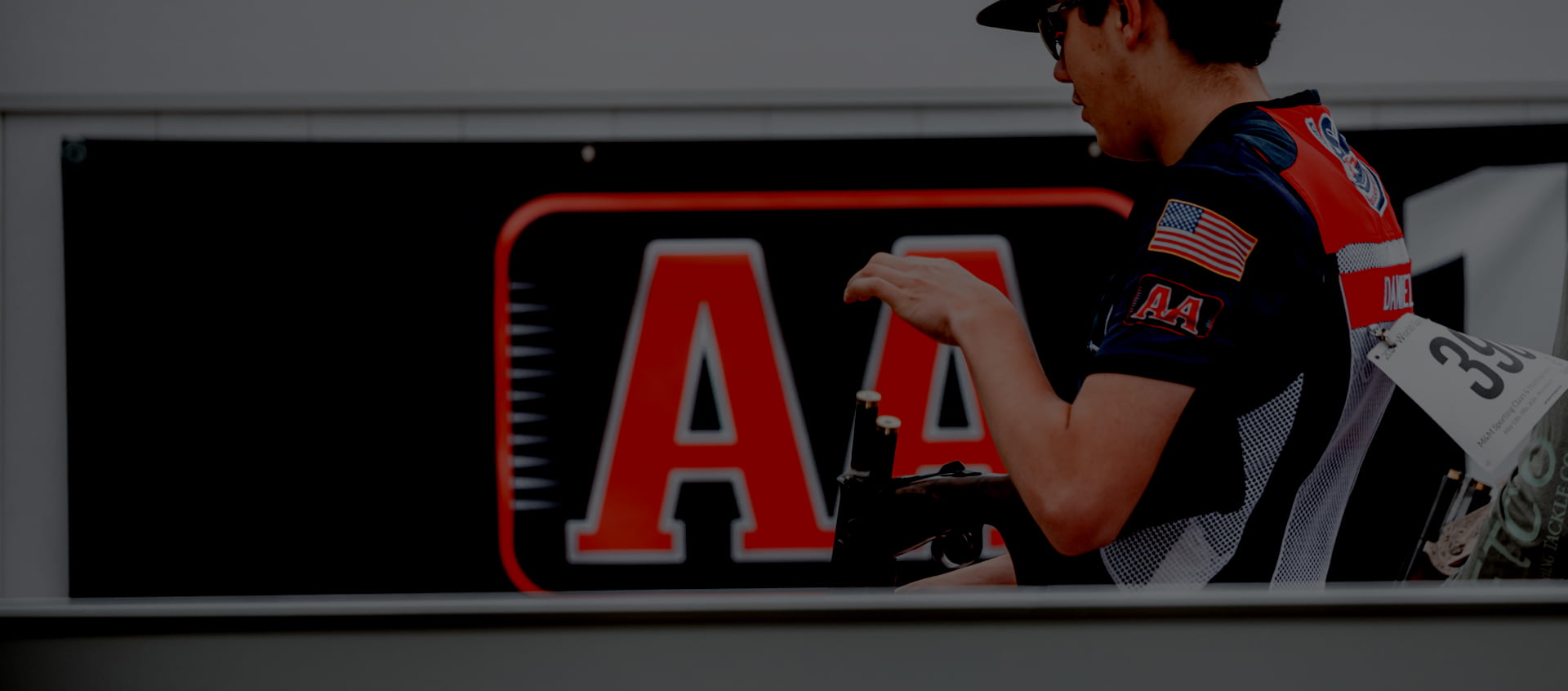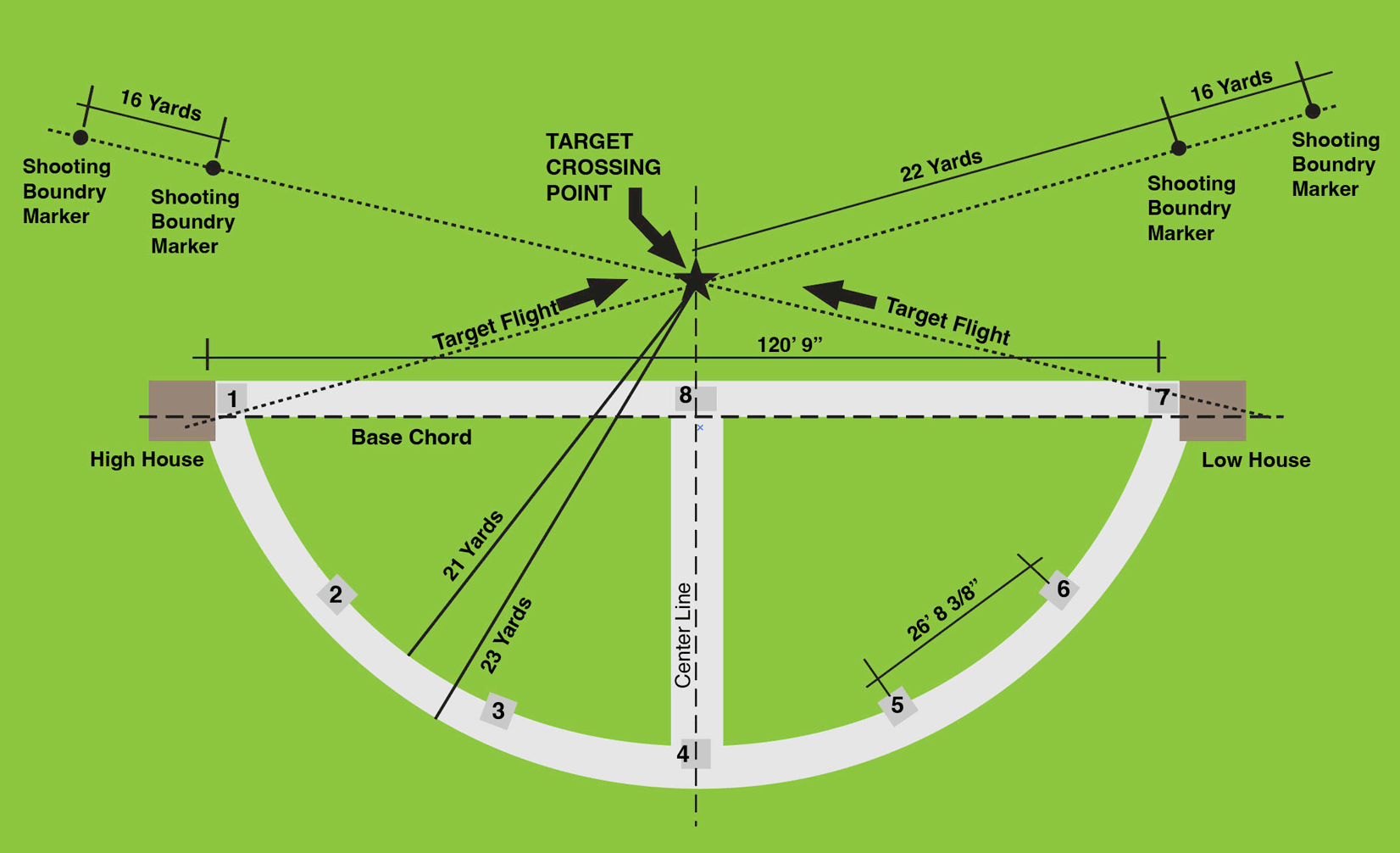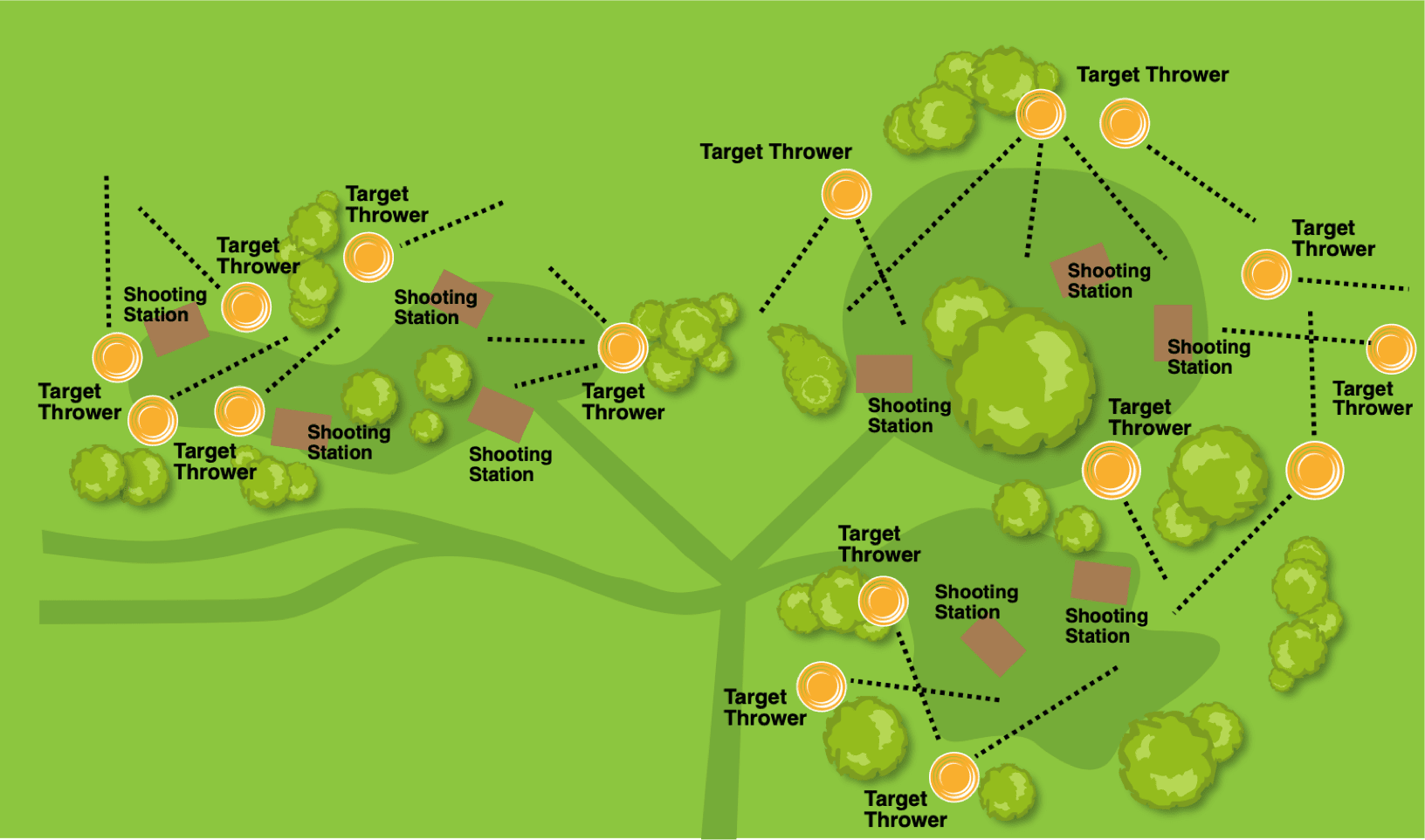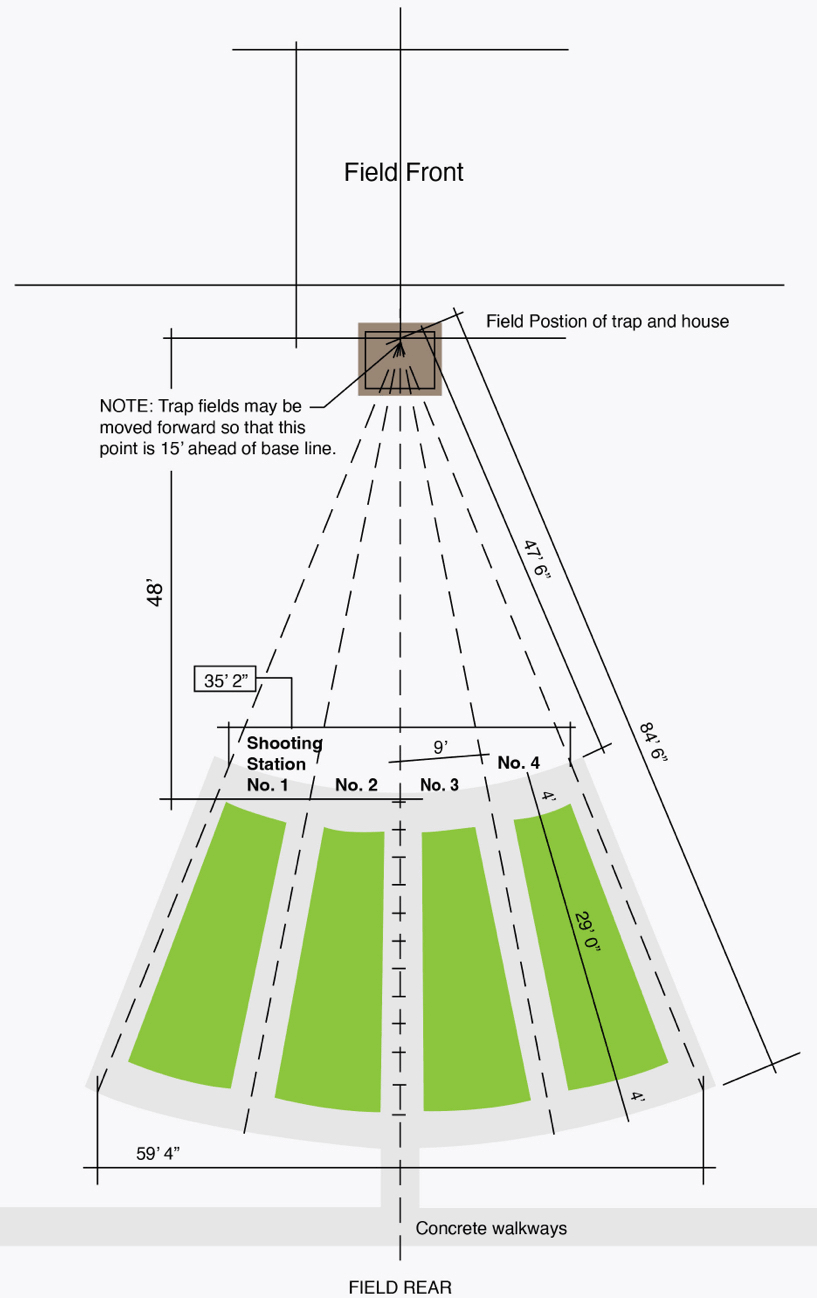
Shotgun Disciplines
Classifying and defining the various shotgun disciplines and clay target games is no easy task. There are almost as many out there as there are shotgunners to shoot them. And new ones spring up all the time. What follows then is not meant to be the final word on the topic — just a helpful guide to the most prominent games played and disciplines followed today. Here, we will talk about 3 disciplines: Trap, Skeet and Sporting.

Trap
TRAP/GOVERNING BODY
- American Trap/ATA
- Olympic Trap/ISSF, USA Shooting
- Olympic Trap Doubles/ISSF, USA Shooting
- Automatic Ball Trap/ISSF
- Universal Trench/ISSF
- ZZ/FITASC
1. American Trap (ATA):
The most basic of all the trap disciplines. Standard targets are thrown as singles. The horizontal direction is randomized with a maximum angle of 22 degrees measured from a line from the trap to the middle station. The height at which the targets are thrown is constant. The distance is constant at 50 yards. A squad of five shoot in rotation from five stations arrayed in an arc located 16 yards behind the traphouse; five targets are thrown at each station, after which the shooters move to the next station on their right. A round is 25 targets with one shot allowed at each target. An English variation is called Down-The-Line, a two-barrel discipline that allows two shots at a single target with a scoring penalty for a second-barrel hit.
Handicap Trap:
The same as ATA singles, except the shooter stands farther back than 16 yards — but no longer than 27 yards. The ATA reviews handicap yardage for shooters every 1,000 targets as part of their handicap system.
Doubles Trap:
As the name implies, two targets are launched simultaneously from one machine. Squads of five shooters rotate the five positions on the 16 yard line. Shooting events consist of 25 or 50 pairs. Like 16 yard and handicap, scoring is one point per target hit.
2. Olympic Trap/Olympic Bunker/Olympic Trench:
An international discipline that incorporates 15 machines. Targets have a minimum height of 1.5 meters and a maximum height of 3.5 meters as measured 10 meters in front of the bunker. Targets are thrown up to 110 mph depending on the target height to get the 70- to 75-meter variable distance required. The maximum target angle is 45 degrees. There are nine set programs for the 15 traps that are used in all countries of the world. A squad of six shooters take turns shooting from five stations. Shooters move to the next station after each target in a shoot-and-move rotation. The shooting stations are located in a straight line. On the call “pull” (phono-pull release system is utilized to ensure equitable target releases), a clay is thrown from one of three fixed traps directly in front of each of five shooters. Two shots may be used for each target with no penalty in scoring. Each shooter gets two lefts, two rights and one straightaway target from each station. Shot charge is restricted to 24 grams (approx. 7/8 oz.) using any safe powder charge (plated shot is allowed).
3. Olympic Trap Doubles/Olympic Bunker Doubles/Olympic Trench Doubles:
Here, two targets are launched simultaneously from two traps of station three’s set of three fixed traps. As in Olympic singles, squads of six shooters shoot in rotation from five stations, shooting a round of 20 or 25 pairs (40 or 50 targets). Scoring is one point per target hit.
4. Automatic Ball Trap (ABT)/Wobble/Continental:
Like ATA trap, the horizontal direction is randomized, but also the target vertical height is varied from 1.5 to 3.5 meters. The horizontal throwing angle is widened from the ATA 22 degrees to 45 degrees. The distance is set at 75 meters. Squads of six shooters shoot in rotation as in Olympic Trap. Two shots are allowed at each target with no penalty scoring. A phono-pull system may be used.
5. Universal Trench:
This form of International trapshooting is also referred to as “Five Trap”; it is a variation of Olympic Trap using only five machines. Squads of six take turns shooting from each of five stations. UT is very similar to Olympic Trap in the speeds, heights and angles of targets. Trap position sequences for a round of 25, though predetermined, are unknown to the squad. Each squad member is allowed two shots at each target with no penalty in scoring. Computer and phono-pull system for target selection are the same as in Olympic Trap.
6. ZZ/Helice/Electrocibles:
A worldwide trap discipline, the target is a two- or three-bladed plastic propeller with a detachable (breakable) center. One of five traps in front of the shooter releases the target on call; two shots are allowed at each target. To score a “kill,” the shooter must knock the center out of the target so that it lands within the confines of a circular fence.

Skeet
SKEET/GOVERNING BODY
- American Skeet/NSSA
- English Skeet/CPSA
- International Skeet/ISSF, USA Shooting

1. American Skeet:
A round of skeet consists of 25 targets in a set sequence of singles and simultaneous doubles. Squads of five shooters take their turns from eight shooting stations. Each squad member takes two singles and one double from stations 1, 2, 6 and 7. Two singles are taken from stations 3, 4, 5 and 8. The 25th target is taken after the first target is missed, or as a final target (low house #8) after 24 kills. Targets are thrown a distance of 60 yards. Variations in the angles of the targets presented from the “high” and “low” house result from the shooter moving from station to station. American Skeet is the only discipline that has regular, specific tournament events for sub-bore shotguns: 20, 28 and .410.
Skeet Doubles:
Shooters, in squads of five, start on station 1, shooting one pair of doubles each to station 7. Then they reverse, shooting one pair each from stations 7 through 1. On station 4, shooters must shoot the high house target first. On reversing (shooting 7 through 1), they must shoot the low house target first. In tournaments, the events are on a total of 50 (or 100) targets with the last pair shot on station 1. Scoring is one point per hit target.
2. English Skeet:
A seven-station version of American Skeet, substituting the singles thrown on station 8 with a double on station 4.
3. International Skeet:
An eight-station format like that of American Skeet with faster targets thrown at 72 meters. The shooter is required to hold the butt of the gun at hip level until the target is seen, which may be delayed for up to 3.5 seconds after the “pull” request. Single and double target sequences are slightly different from American Skeet with a high single and one pair of doubles from Stations 1 and 2; high and low singles and one pair of doubles from Stations 3, 4 and 5 (on Station 4, the high bird must be attempted first in doubles); a single low and a double from Station 6; one pair of doubles from Station 7; and a single high and a single low from Station 8. A round is 25 targets (no option shot). Like Olympic Trap, shot charge is restricted to 24 grams (approx. 7/8 oz.), with any safe powder charge. For tournaments, all shells must be of the same type and load.

Sporting
Clays
GOVERNING BODIES:
TRAP/GOVERNING BODY
- American Trap/ATA
- Olympic Trap/ISSF, USA Shooting
- Olympic Trap Doubles/ISSF, USA Shooting
- Automatic Ball Trap/ISSF
- Universal Trench/ISSF
- ZZ/FITASC
SKEET/GOVERNING BODY
- American Skeet/NSSA
- English Skeet/CPSA
- International Skeet/ISSF, USA Shooting
SPORTING/GOVERNING BODY
- English Sporting/CPSA & American Sporting/NSCA, SCA
- FITASC or International Sporting/FITASC, NSCA
- 5-STAND SPORTING®/NSCA

1. English or American Sporting:
Sporting Clays, like Trap and Skeet, uses traps and clay targets to duplicate, as far as possible, conditions and presentations you would normally find while hunting. A typical sporting course is laid out over a 10-, 20- or 30-acre site, ideally in rough, hilly terrain. Usually, the path the shooters follow will take a circular or horseshoe shape, enabling shooters to start and finish in roughly the same place. Along the path, targets are thrown from 10 to 14 shooting stations. Courses can be laid out with either automatic or manual traps, usually set out of sight. Six different types of targets can be used: Standard, Midi, Mini, Battue, Rocket or Rabbit. Target sequence may incorporate singles, report pairs, following pairs and true (simultaneous) pairs. A round usually consists of 50 or 100 targets.
2. FITASC Sporting/International Sporting:
The most challenging form of sporting shooting, it is the French version of practice for field shooting. Unlike the free and easy format of English or American Sporting, FITASC Sporting is shot in squads of up to six with a fixed order of stands (parcours in French) that are shot in strict rotation. A competition normally consists of 200 targets shot over three days in eight rounds of 25. In each round of 25, shots are taken from at least three different stands. The shooter is required to hold the butt of the gun below armpit level until the target is seen. Great variety and lack of repetition is accomplished by use of a number of traps. Single targets are first shot by the entire squad. After the entire squad has completed the singles, combinations of the singles are presented as doubles. Here, as in English Sporting, all six types of clays are used. Generally speaking, targets tend to be at longer ranges with the added challenge of a continual variation of speeds, angles, distances and target combinations.
3. 5-STAND SPORTING®:
Sometimes overlayed on a trap or skeet field, this game uses six to eight automatic traps. There are three levels of difficulty: Level I, five single targets with full use of the gun for scoring; Level II, three single and a simultaneous pair; Level III, one single and two simultaneous pairs. Shooters (squad of five) can move from station to station with a predetermined menu of shots and combinations or in a sequence unknown to the shooters. 5-STAND SPORTING® is a registered trademark of Clay-Sport International, Inc. , Alberta, Canada. In the U.S., 5-STAND® is licensed by the NSCA

